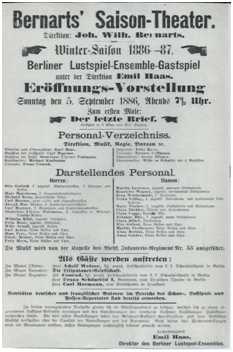Bernarts Theater
| Bernharts Theater | |

|
|
| location | |
| Address: | Adalbertstrasse 20-24 |
| City: | Aachen |
| Coordinates: | 50 ° 46 '29 " N , 6 ° 5' 21" E |
| Architecture and history | |
| Opened: | 1862 |
| Named after: | Matthias Bernarts (1862) |
| In 1910 the theater was closed. | |
The Bernarts Theater in Aachen (also called Bernarts Lokal ) was one of the most famous private entertainment and theater stages in the Rhineland from 1862 to 1910 .
history
The merchant and wine wholesaler Matthias Bernarts opened a large theater and society house in Aachen's Adalbertstrasse, right in the center. To this end, he had his entertainment restoration, which was located here earlier, extensively rebuilt and expanded. The reopening took place on October 26th. In addition to a smaller, so-called “Moorish Hall” in an oriental ambience, there was now also a large ballroom with 1500 seats and a spacious stage. For open-air theater plays in the summer, the hall had a sliding rear that could be opened outwards.
In addition to the military and entertainment concerts shown earlier, there were now more popular attractions such as “The Optical and Physical World Theater”, “Scottish Glockenspielers” or performances by Spanish dancers from Madrid. There were demanding classical soirees with violin and piano virtuosos or even the “ St. Matthew Passion ” in 1861 with theater staff under the direction of music director Franz Wüllner . After the theater performances, which were initially only shown in the summer bathing season, you could soon experience comedies, Jacques Offenbach's new operettas and in January / February carnival performances here . The city orchestra also moved into the spacious hall near Bernarts from the winter of 1862 and stayed here with the concerts until its own house was built in 1864/65.
The Bernarts Theater had become a competition for the city theater . Soon, however, there was close cooperation between his director William Grundner and Josef-Wilhelm Bernarts (the son and successor of Matthias Bernart). From the winter season 1880/81, the city theater ensemble also played operas, classical plays, comedies and antics here. Since the city administration did not agree, Bernarts continued to run his house on his own. Recognizing the spirit of the times, he devoted himself progressively to the new trends of the late 19th century with the program. In addition to classics, the new sensational works of naturalism by Gerhart Hauptmann , Henrik Ibsen and Frank Wedekind were on the program. Guest performances by well-known artists such as Sarah Bernhardt from Paris caused a sensation.
With his modern repertoire policy, Josef-Wilhelm Bernarts was way ahead of the city theater, which was still arrested in outdated structures. Actors like Paul Wegener or Werner Krauss later began their careers here at the beginning of the 20th century. The revue singer, cabaret artist and emcee in the "Cabaret of Comedians" Willi Schaeffers , Max Mack , a silent film director and the actress Emilia Unda appeared.
However, due to increasing financial problems and a lack of municipal support, the visible artistic upward trend could not prevent the stage from finally having to close at the end of the 1909/10 season after almost 50 years.
literature
- Politisches Tageblatt , Aachen - years 1860 to 1911
- Echo of the Present , Aachen - Years 1860 to 1911
- Elmar Buch, Bernd Vogelsang: Historical Atlas of the Rhineland (theater since the 18th century); Cologne 1989, ISBN 3-7927-1130-3
- Wolfgang Goetz: Werner Krauß (biography); Hamburg 1954
- Wolfgang Noa: Paul Wegener (biography); Berlin 1964
- Klaus Schulte, Peter Sardoc: From Comedy House to City Theater - The History of Aachen City Theater (unpublished manuscript)
- Klaus Schulte, Peter Sardoc: From Ringelhardt to Mundorf ; Aachen 1977, ISBN 3-88154-013-X
Web links
- The history of Bernart's theater , in: Aachener Zeitung , 25 August 2017
- Posters from the Bernarts Theater , in: Klenkes-Stadtmagazin from November 14, 2017
- City archive: The Bernarts Theater's poster collection can be restored , in: Focus-online-local from August 25, 2017